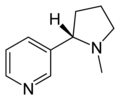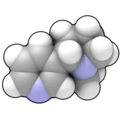| Nicotine | |
|---|---|

 |
|
| General | |
| Chemical name | (S)-3-(1-Methyl-2-pyrroli- dinyl)pyridine |
| Chemical formula | C10H14N2 |
| Molecular mass | 162.23 g/mol |
| CAS number | 54-11-5 |
| SMILES | [H][C@@]2(N(C)CCC2)c1cccnc1 |
| Properties | |
| Density | 1.01 g/ml |
| Melting point | -79 °C |
| Boiling point | 247 °C (decomposes) |
| Autoignition temperature | 240 °C |
| Flash point | 95 °C |
| Vapour Pressure | 0.006 kPa at 25 °C |
| Viscosity | 2.7 mPa·s at 25 °C 1.6 mPa·s at 50 °C |
| Surface Tension | 37.5 dyn/cm (37.5 mN/m) at 25.5 °C 37.0 dyn/cm (37.0 mN/m) at 36.0 °C |
|
Except where noted otherwise, data are given
for materials in their standard state (at 25 °C, 100 kPa) |
|
Nicotine is an alkaloid found in the nightshade family of plants (Solanaceae), predominantly in tobacco, and in lower quantities in tomato, potato, eggplant (aubergine), and green pepper. Nicotine alkaloids are also found in the leaves of the coca plant. Nicotine constitutes 0.3 to 5% of the tobacco plant by dry weight, with biosynthesis taking place in the roots, and accumulates in the leaves. It is a potent neurotoxin and is included in many insecticides.
In lower concentrations, the substance acts as a stimulant and is one of the main factors responsible for the dependence-forming properties of tobacco smoking.
Contents |
Chemistry
Nicotine is a hygroscopic, oily liquid that is miscible with water in its base form. As a nitrogenous base, nicotine forms salts with acids that are usually solid and water soluble. Nicotine easily penetrates the skin. As shown by the physical data, free base nicotine will burn at a temperature below its boiling point, and its vapors will combust at 95 °C in air despite a low vapor pressure. Because of this, most nicotine is burned when a cigarette is smoked; however, enough is inhaled to provide the desired effects.
Pharmacology
Pharmacokinetics: As nicotine enters the body, it is distributed quickly through the bloodstream and can cross the blood-brain barrier. On average it takes about seven seconds for the substance to reach the brain. The half life of nicotine in the body is around 2 hours[1]. The amount of nicotine inhaled with tobacco smoke is a fraction of the amount contained in the tobacco leaves (most of the substance is destroyed by the heat). The amount of nicotine absorbed by the body from smoking depends on many factors, including the type of tobacco, whether the smoke is inhaled, and whether a filter is used. For chewing tobacco, often called dip, snuff, or snus, which is held in the mouth between the lip and gum, the amount released into the body tends to be much greater than smoked tobacco.
Dynamics
Nicotine acts on the nicotinic acetylcholine receptors. In small concentrations it increases the activity of these receptors, among other things leading to an increased flow of adrenaline, a stimulating hormone. The release of adrenaline causes an increase in heart rate, blood pressure and respiration, as well as higher glucose levels in the blood. Cotinine is a break-down product of nicotine which remains in the blood for up to 48 hours and can be used as an indicator of a person's exposure to smoke. In high doses, nicotine will cause a blocking of the nicotinic acetylcholine receptor, which is the reason for its toxicity and its effectiveness as an insecticide.
In addition, nicotine increases dopamine levels in the reward circuits of the brain. Studies have shown that smoking tobacco inhibits monoamine oxidase (MAO), an enzyme responsible for breaking down monoaminergic neurotransmitters such as dopamine, in the brain. It is currently believed that nicotine by itself does not inhibit the production of monoamine oxidase (MAO), but that other ingredients in inhaled tobacco smoke are believed to be responsible for this activity. In this way, it generates feelings of pleasure, similar to that caused by cocaine and heroin, thus causing the addiction associated with the need to sustain high dopamine levels.
Toxicology
The LD50 of nicotine is 50 mg/kg for rats and 3 mg/kg for mice. 40–60 mg can be a lethal dosage for adult human beings. This makes it an extremely deadly poison. It is more toxic than many other alkaloids such as cocaine, which has a lethal dose of 1000 mg.
The carcinogenic properties of nicotine in standalone form, separate from tobacco smoke, have not been evaluated by the IARC, and it has not been assigned to an official carcinogen group. The currently available literature indicates that nicotine, on its own, does not promote the development of cancer in healthy tissue and has no mutagenic properties. Its teratogenic properties have not yet been adequately researched, and while the likelihood of birth defects caused by nicotine is believed to be very small or nonexistent, nicotine replacement product manufacturers recommend consultation with a physician before using a nicotine patch or nicotine gum while pregnant or nursing. However, nicotine and the increased acetylcholinic activity it causes have been shown to impede apoptosis, which is one of the methods by which the body destroys unwanted cells (programmed cell death). Since apoptosis helps to remove mutated or damaged cells that may eventually become cancerous, the inhibitory actions of nicotine creates a more favourable environment for cancer to develop. Thus nicotine plays an indirect role in carcinogenesis. It is also important to note that its addictive properties are often the primary motivating factor for tobacco smoking, contributing to the proliferation of cancer.
At least one study has concluded that exposure to nicotine alone, not simply as a component of cigarette smoke, could be responsible for some of the neuropathological changes observed in infants dying from Sudden Infant Death Syndrome (SIDS).[2]
It has been noted that the majority of people diagnosed with schizophrenia smoke tobacco. Estimates for the number of schizophrenics that smoke range from 75% to 90%. It was recently argued that the increased level of smoking in schizophrenia may be due to a desire to self-medicate with nicotine. [3] [4] More recent research has found the reverse, that it is a risk factor without long-term benefit, used only for its short term effects. [5]However, research on nicotine as administered through a patch or gum is ongoing.
Therapeutic uses
The primary therapeutic use of nicotine is in treating nicotine dependence (smoking). Controlled levels of nicotine are given to a patient through gums, dermal patches, or nasal sprays in an effort to wean them off of their dependence.
Recent studies have indicated that nicotine can be used to help adults suffering from autosomal dominant frontal lobe epilepsy. The same areas that cause seizures in that form of epilepsy are also responsible for processing nicotine in the brain.
Some research has also shown that nicotine can lessen symptoms of mild to moderate ulcerative colitis.
Nicotine and its metabolites are being researched for the treatment of a number of disorders, including ADHD and Parkinson's Disease.
History and name
Nicotine is named after the tobacco plant Nicotiana tabacum, which in turn is named after Jean Nicot, a French ambassador, who sent tobacco and seeds from Portugal to Paris in 1550 and promoted their medicinal use. Nicotine was first isolated from the tobacco plant in 1828 by German chemists, Posselt & Reimann. Its chemical empirical formula was described by Melsens in 1843, and it was first synthesized by A. Pictet and Crepieux in 1893.
See also
References
- ^ http://scholar.google.com/url?sa=U&q=http://jpet.aspetjournals.org/cgi/reprint/221/2/368.pdf
- ^ Machaalani et al. (2005) "Effects of postnatal nicotine exposure on apoptotic markers in the developing piglet brain"
- ^ Schizophr. Res. 2002
- ^ Am. J. Psychiatry 1995
- ^ Br. J. Psychiatry 2005
Further reading
- Guardian article: "Nicotine could soon be rehabilitated as a treatment for schizophrenia, Alzheimer's and Parkinson's diseases, as well as hyperactivity disorders."
- Nicotine Therapy for ADNFLE: "Nicotine as an antiepileptic agent in ADNFLE: An n-of-one study"
- Minna, John D.: "Nicotine exposure and bronchial epithelial cell nicotinic acetylcholine receptor expression in the pathogenesis of lung cancer"
- Fallon, J.H., et al. (2005) Gender: A major determinant of brain response to nicotine. International Journal of Neuropharmacology. 8:1-10. [1]
- West, Kip A., et al.: "Rapid Akt activation by nicotine and a tobacco carcinogen modulates the phenotype of normal human airway epithelial cells"
- National Institute on Drug Abuse
- Powledge TM (2004) Nicotine as therapy. PLoS Biol 2(11): e404.: [2]




 216.73.216.81
216.73.216.81 User Stats:
User Stats:
 Today: 0
Today: 0 Yesterday: 0
Yesterday: 0 This Month: 0
This Month: 0 This Year: 0
This Year: 0 Total Users: 117
Total Users: 117 New Members:
New Members:
 216.73.xxx.xx
216.73.xxx.xx
 Server Time:
Server Time: